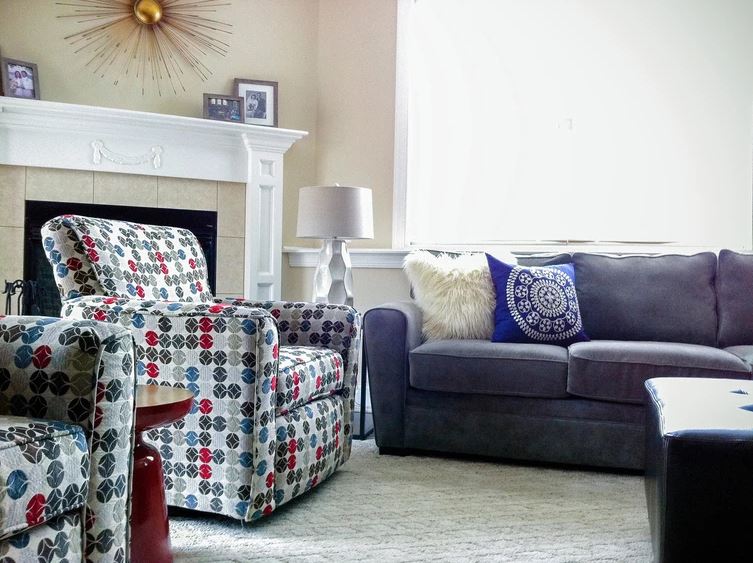How to Choose Colors for Your Home and How to Fix a Bad Color Problem
source: meredithellisdesign.com
Lack of understanding of color is one of the most common reasons a room may not be coming together, and it can take many forms.
1. Too many colors that don’t relate.
Identify the issue: Take a look around…not counting neutrals, do you see more than 3 main colors (and variations of those colors) in the room? If you see more than that, this may be your issue. Try to imagine all of your colors stacked on top of each other. If they wouldn’t look nice in a pile, they probably don’t look great spread apart in the same room either.
Preventative Solution: As you set out to choose colors for your space, select one piece with a great pattern highlighting some colors you love and go from there. Select every other piece for the room with that inspiration piece in mind. If at all possible, order a sample of the fabric, wallpaper or rug so that you can bring it with you when shopping for the rest of the space.
Fix the problem when it’s too late: If you’ve made a mistake on an expensive piece, say a piece of upholstery or a rug that you can’t return, just start decorating around it! Find accessories and artwork that compliment that color and stick to it.
Example: Here are two great examples from Lindsay Speace Design.
Lindsay uses color beautifully. I would be willing to bet that Lindsay chose either the ottoman fabric or the lounge chair fabric before any other item in the room and then she went from there.
Notice how all the colors in the room relate to one another. She chose creamy neutrals for the drapery and rug to work with the creamy background color of the ottoman. If she were given a heftier budget for this project, she could have added a crown molding in a sage green or a more conservative creamy white to really bring the colors full circle.
source: www.lindsayspeace.com
Take a look at the second photo with the blue headboard and see if you can identify everything Lindsay did right to marry the colors in the room and create a unified look, even with a ton of colors in play. It works beautifully!
source: www.lindsayspeace.com
Here’s an example of a pop of color that really doesn’t work:
A pop of color doesn’t necessarily mean you want one item to literally pop out at you, which in this case it really does.
This room is beautiful and has so many lovely pieces, but the electric blue tables really steal the show and detract from the classic vibe that this room would otherwise have without the tables. The blue doesn’t relate to anything else in the space so it feels out of place here.
2. Clashing neutrals
Identify the issue: So you decided on an all neutral room because you know you won’t be able to pull vibrant colors together cohesively and let’s face it, neutral spaces are more trendy than high-rise skinny jeans.
Well guess what? Those perfectly curated neutral rooms that you keep seeing were done mostly by professionals and neutrals come with their own set of problems. Most notably, grays, whites and beiges are not all the same and
they most certainly do NOT all go together.
If you are looking around your room and your gray rug reads blue and your gray walls read cream, well then it’s time to call the painter.
Preventative Solution: Remember that all neutrals come with their own set of undertones. It’s your job to identify those undertones (or hire a professional who can) and make sure you’re choosing other elements that compliment that undertone. If your couch is a variation of beige, then don’t choose a cool gray to paint your walls. If you’re going with a neutral for your walls, choose a warm white, warm greige, or a coordinating beige. And always remember to choose your paint colors last!
Fix the problem when it’s too late: if you already purchased expensive items like upholstery, rugs and/or drapery, it’s not the end of the world. Maybe you can make some changes down the road or switch some pieces to a different room in your house, but for now, just
decide which large piece rules the room
(maybe a large sofa or rug) and start decorating and accessorizing with that piece in mind. Purchase some artwork that relates to that piece and then paint the walls to bring it all together.
Example: Here’s an example of a homeowner who may not have considered the gold/yellow tone of the brick fireplace surround when they chose a blue/green gray for the built-ins. A giant fireplace with yellow brick cannot be ignored when selecting other elements for the room.
Selecting a creamy neutral with the correct undertone would have helped this fireplace blend in rather than stick out like the sore thumb that it is. Yes, gray, beige, and white are all neutrals, but they all come with undertones and this is a great example of why they can’t be ignored.
3. Wall color
Identify the issue: If you’ve already used my suggestion and imagined all the items in your room stacked on top of one another and you actually think all the colors work well together, then your problem might be on the walls.
If you have a neutral on your walls (white, gray, or beige), what would you identify the undertone as? Does that undertone work well with the rest of the elements in your room?
For example, if your neutral walls have pink undertone, but most of the items in your room are blue or yellow, then you are almost always going to feel like something is off.
Preventative Solution: Choose paint LAST! If you’re gearing up to paint your walls before you’ve purchased any rugs or furniture, let me stop you now. Just stop...seriously.
Put your paintbrush down and just take a seat.
If you select all furnished goods and floor coverings BEFORE paint, you’re giving yourself a much better chance at getting the paint selection right from the beginning. Remember, identify the undertones and the general color theme of your space and then find a wall color with those same undertones, or an undertone that compliments what you have.
Fix the problem when it’s too late: this one is easy...if you’ve already painted and it’s not working, I have one solution for you. Head back to the paint shop and get yourself some new paint and get crackin!
Example: I hate myself for showing this as an example of poor color selections because Shae McGee is basically the best designer since Elsie de Wolfe, but this image helps me illustrate my point, so hopefully the design gods don’t punish me for this one…
Notice the gold hued rug (that I’m SURE Shae did not choose), but for whatever reason, she did decide to ignore it when it came time to design with the rug in mind.
When you’re working with a heinous rug such as this one, and you or your client simply can’t find the money to replace it, you still can’t ignore it because it’s one of the largest elements in the room,
therefore it’s kind of running the show.
If you simply remove the rug, the colors in this room work BEAUTIFULLY together. But that’s just it...the rug wasn’t removed. So it’s there, kind of ruining this otherwise beautifully designed room.
You can see that she tried to cover it up with the pretty area rug that works with the rest of the room, but again, doesn’t work with the gold rug. The pink on the walls, the creamy grays and stark whites will simply never work with that wall-to-wall gold rug in place.
Moral of the story is that if this rug looks like a rug in your home, you either need to pony up the dough to replace it, or you need to choose a color scheme that works with it, not against it.
4. Ignoring Things You You Simply Can’t Ignore
One of the most gigantic issues I see when I step into a clients’ home is that they are trying to bring certain colors into their home without considering or changing the fixed elements that are completely ruling the room (similar to the gold rug example from above).
Identify the issue: If you look around your room and there is any type of fixed element in the room (wall tile, floor tile, fireplace surround, wall-to-wall carpet -- or any other item you can’t move), and you never even thought of considering this element when planning the rest of your space, well….
Herin lies your issue.
Preventative Solution: Take a look around the room you’re attempting to design. If there is a fixed element of any sort, except maybe a wood floor,
you MUST make color decisions considering this element.
This fixed element is the starting point for selecting the REST of the colors for your space. If you inherited a home with white fixed elements, congratulations, you have won the homeowners lottery. If you have pine boards covering your walls, a black and gray mosaic backsplash, or (gasp) a pink toilet, you either need to bring in the sledgehammer, or you need to make all your decisions considering this element.
Fix the problem when it’s too late: Oyyyy I hope you’re all reading this before I point out that you’ve screwed up, otherwise I just feel bad for showing you the light. Don’t worry! There’s always a solution, including just pretending it’s not happening...ha.
Seriously though. If you’ve already designed without that massive fixed element in mind, you simply need to decide if you care enough to change it, and if so, which will be less expensive fix; Change the furnishings or change the fixed element. My guess will be the fixed element unless you shop at Ikea.
Example: Here you can see that this homeowner tried to bring a modern vibe into their home with modern colors like black/white/red, electric blue, and gray. Whether you love the furnishings or not, they simply will never work unless that fireplace tile (and probably the traditional mantle) is removed.
Whomever designed the space tried to tie it all together with the creamy wall color and creamy rug, but the only way to make this room cohesive will be to select furnishings that work with that tile or change the tile (and wall color and rug).
Assuming this homeowner did not choose the fixed elements of the room (tile and mantle), they appear to be more modern folks. I would advise that they spend the money ($1,500-$3,000) to replace the fireplace tile and mantle (and that chair rail!) and find something that works better with their more modern style. Then they can repaint the walls, select a new rug and voila! A well designed space that works with their modern taste.
This was part one of our blog series that will help you figure out why in the world your home simply doesn’t feel right. Next up, we will take you through some common space planning mishaps. Thank you for reading!
If you’re looking for a professional interior designer or decorator in the central New York area, The Ivory Slate provides full service interior design as well as more specific services including interior paint consultations, exterior paint consultations, 3D renderings for renovations and new builds, photorealistic renderings, space planning, custom furniture design, custom window treatment design, lighting plans, and much more!
#theivoryslate #centralnyinteriors #centralnewyorkinteriordesigner #centralnewyorkdecorator #cnydecorator #centralnydecorator #cnyinteriordesigner #syracuseinteriors #cazenoviainteriors #skaneatelesinteriors #cazenoviadecorator #skaneatelesdecorator #syracusedecorator #syracusedesigner #3drenderings #spaceplanning #paintselections #paintconsulation #colorexpert #benjaminmoore #benjaminmoorecolors #renovations #furnitureselections #windowtreatments #lightingplans #customwindowtreatments #windowcoverings #familyfriendlyfabric #walldecor #interiordesign #decorator







